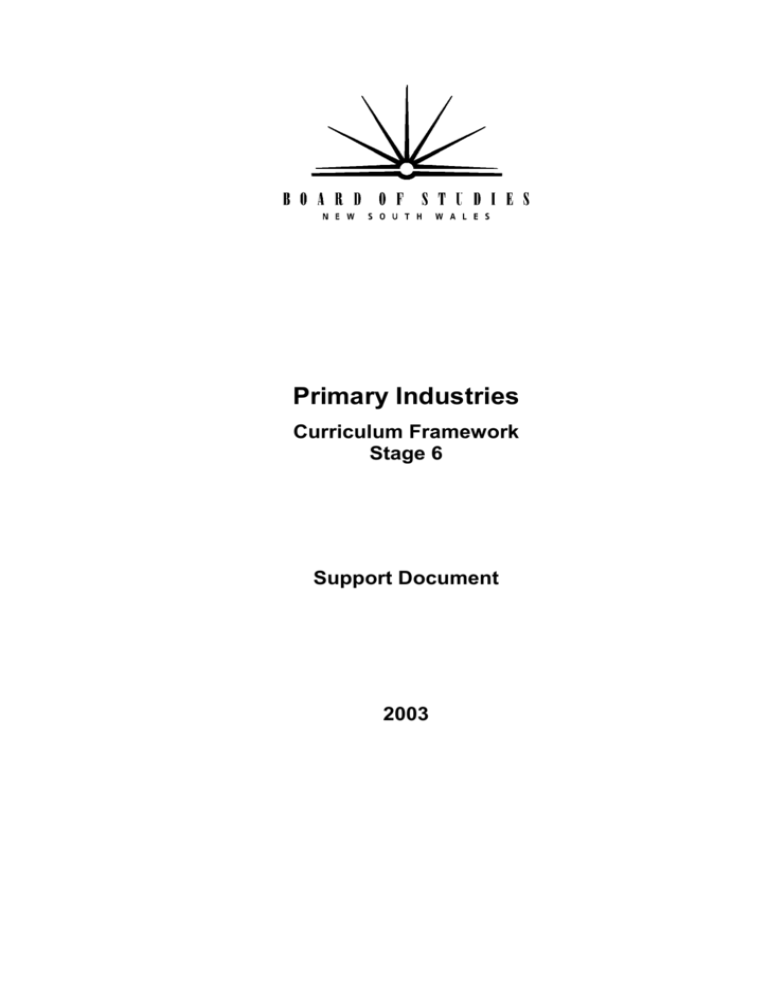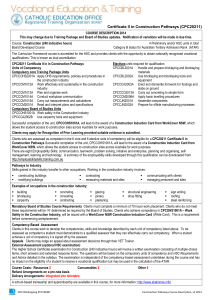
Primary Industries
Curriculum Framework
Stage 6
Support Document
2003
Acknowledgement
Material from the Conservation and Land Management (RTD02), Amenity Horticulture (RTF03), Rural
Production (RTE03) and Food Processing (FDF03) Training Packages included in this document is
© Australian National Training Authority (ANTA). Reproduced with permission.
The following copyright warning applies to the material from the Training Package:
All rights reserved. This work has been produced initially with the assistance of funding provided by
the Commonwealth Government through ANTA. This work is copyright, but permission is given to
trainers and teachers to make copies by photocopying or other duplicating processes for use with their
own training organisations or in a workplace where the training is being conducted. This permission
does not extend to the making of copies for use outside the immediate training environment for which
they are made, nor the making of copies for hire or resale to third parties. The views expressed in this
version of the work do not necessarily represent the views of ANTA. ANTA does not give warranty
nor accept any liability.
The Board of Studies owns the copyright on all syllabus support documents. Schools and colleges may
reproduce this document in part or in full for bona fide study or classroom purposes only. Acknowledgement of
the Board of Studies copyright must be included on any reproductions. Students may copy reasonable portions
of the syllabus support document for the purposes of research or study. Any other use of this document must be
referred to the Copyright Officer, Board of Studies NSW.
The Board of Studies has made all reasonable attempts to locate owners of third party copyright material and
invites anyone from whom permission has not been sought to contact the Copyright Officer, Board of Studies
NSW, 117 Clarence St, Sydney NSW 2000, tel (02) 9367 8289, fax (02) 9279 1482.
© Board of Studies NSW 2003 for and on behalf of the Crown in right of the State of New South Wales.
Published by
Board of Studies NSW
GPO Box 5300
Sydney NSW 2001
Australia
Tel: (02) 9367 8111
Fax: (02) 9367 8484
Internet: www.boardofstudies.nsw.edu.au
ISBN 1 7409 9928 2
2003700
Contents
1 Primary Industries Curriculum Framework……………………………………….……6
1.1 Introduction………………………………………………………………….…… 6
2 Course Delivery…………………………………………………………………….. 8
2.1 General Information……………………………………………………………… 8
2.2 Sequence of Delivery…………………………………………………………….. 9
2.2.1 Relationships between units of competency……………………………... 9
2.2.2 Category status of units of competency for qualifications available in
the Primary Industries Curriculum Framework………………………….. 10
Table 1 Certificate II in Conservation and Land Management, Rural
Operations, Agriculture and Horticulture…………………..….. 11
Table 2 Certificate II in Agriculture specialising in Beef Production,
Dairy Production, Goat Production, Horse Breeding, Pig
Production and Poultry Production…………………………….. 18
Table 3 Certificate II in Agriculture specialising in Sheep and Wool
Production, Grain Production and Cotton Production, and
Irrigation and Production Horticulture……………….………... 32
Table 4 Certificate II in Crutching, Shearing and Wool Handling……... 46
Table 5 Certificate III in Advanced Wool Handling, Conservation and
Land Management, Rural Operations, Agriculture (Beef
Production) and Agriculture (Cotton Production)………...…… 55
Table 6 Certificate III in Agriculture (Dairy Production), Agriculture
(Goat Production), Agriculture (Grain Production),
Agriculture (Horse Breeding), Agriculture (Pig Production)
and Agriculture (Poultry Production)…………………………. 69
Table 7 Certificate III in Agriculture (Sheep and Wool Production),
Agriculture (Sugar Production), Irrigation, Horticulture and
Wool Clip Production…………………….……………………. 83
2.2.3 Context of assessment for Units of Competency………………………… 97
2.2.4 Selecting elective units of competency to meet HSC course
requirements and qualification packaging rules……………………….… 98
2.2.4.1 Primary Industries (240 indicative hours)………………….…. 99
Example 1 Conservation and Land Management……………. 99
Example 2 Rural Operations…………………………………. 100
Example 3 Agriculture – working with livestock……………. 101
Example 4 Agriculture – working with plants……………….. 102
Example 5 Horticulture…………………………………….… 103
Example 6 Beef Production………………………………….. 104
Example 7 Goat Production……………………………..…… 105
Example 8 Pig Production……………………………………. 106
Example 9 Sheep and Wool Production………………………107
Example 10 Grain Production…………………………………. 108
Example 11 Production Horticulture………………………….. 109
2.2.4.2 Primary Industries (240 indicative hours) plus Primary
Industries Specialisation Study………………………………… 110
Example 1 Dairy Production…………………………………. 110
Example 2 Horse Breeding…………………………………... 112
Example 3 Poultry Production……………………………….. 113
Example 4 Cotton Production………………………………... 115
Example 5 Sugar Production…………………………………. 117
Example 6 Irrigation…………………………………………. 119
Example 7 Crutching………………………………………….121
Example 8 Shearing………………………………………….. 122
Example 9 Wool Handling…………………………………… 123
Example 10 Advanced Wool Handling……………………….. 124
2.2.4.3 Primary Industries Extension……………………………..……. 126
Example 1 Conservation and Land Management……………. 126
Example 2 Rural Operations…………………………………. 127
Example 3 Agriculture……………………………………….. 128
Example 4 Horticulture………………………………………. 129
Example 5 Beef Production………………………………….. 130
Example 6 Cotton Production………………………………... 131
Example 7 Dairy Production…………………………………. 132
Example 8 Goat Production………………………………….. 133
Example 9 Grain Production…………………………………. 134
Example 10 Horse Breeding………………………………….. 135
Example 11 Pig Production…………………………………… 136
Example 12 Poultry Production……………………………….. 137
Example 13 Sheep and Wool Production………………………138
Example 14 Sugar Production…………………………………. 139
Example 15 Production Horticulture………………………….. 140
Example 16 Irrigation…………………………………………. 141
Example 17 Wool Clip Preparation…………………………… 142
2.2.5 The timing of work placement…………………………...…………...….. 143
2.2.6 Traineeships and Vocational Training Orders……………………..…….. 143
3 Teaching Programs…………………………………………………………………..… 144
3.1 An Integrated Approach to Programming – Using a Theme…………………..… 144
Sample Program 1 Working in the industry……………………………………. 145
Sample Program 2 Don’t fence me in…………………………………………...171
Sample Program 3 Weed control and chemical application and safety…………188
3.2 An Integrated Approach to Programming – Using Projects or Events….……..… 208
3.3 Programming Individual Units of Competency………………………….…...…. 209
Sample Program 4 Weather or not………………………………………………210
4 Assessment……………………………………………………………….……………. 216
4.1 Industry Curriculum Frameworks – The Purposes of Assessment……...……..… 216
4.2 Assessment for AQF Certification………………………………………….……. 216
4.2.1 Guiding principles for assessment materials……………………..……….216
4.2.2 Integration of key competencies in Training Packages……………..…… 221
4.2.3 Principles for designing and conducting assessments………………….... 223
4.2.4 List of assessment resources…………………………………..…………. 229
4.2.5 Programming assessment………………………………….…………….. 229
4.3 Recording Assessment…...…………..…………………………………………... 230
4.3.1 Competency Record – sample unit of competency record sheet………... 231
4.4 Sample Assessment Items…..…………………..……………………………….. 232
4.4.1 Observe and report on weather…………………..………………………. 232
4.4.2 Environmental issues………………………………………..…………… 233
4.4.3 Respond to a simulated fencing accident………………………..……….. 234
4.4.4 Native and introduced fauna………………………………………..……. 236
4.4.5 Farm safety check………………………..………………………………. 239
4.4.6 Risk assessment……………………………………..…………………… 241
4.4.7 Manage a chemical spill………………………………………..…………243
4.4.8 Operate tractors………………………………………………..…………. 244
4.4.9 Assessment advice form – repairs to farm fences………………………... 245
4.4.10 Observation guide RTC2209A Install, maintain and repair fencing…….. 246
4.4.11 Observation guide RTE2117A Pen sheep……………………….………. 248
4.5 The HSC Examination…………………..……………………………………….. 249
4.5.1 Internal examinations………………………………………………..…… 249
5 Work Placement………………………………………………………………..………. 250
5.1 Principles Underpinning Work Placement in the Higher School Certificate…..... 250
5.2 Work Placement for Primary Industries Courses…..………………………..…... 252
6 Other……………………………………..…………………………………………….. 253
6.1 Use of Animals for Educational Purposes……..……………………..………….. 253
6.2 Teaching and Learning Materials……..…………………………..……………... 255
6.3 Legislation……………………………………………………………………..….255
6.3.1 Noxious Weeds Act 1993 (NSW)……………………………………….... 256
6.3.2 Code of Practice for the Control of Workplace Hazardous Substances
1996 (NSW)……………………………………………………………… 257
6.3.3 Threatened Species Conservation Act 1995 (NSW) and Threatened
Species Conservation Amendment Act 2002 (NSW)……….….……….... 258
6.3.4 Protection of the Environment Operations Act 1997 (NSW)…………..... 259
6.3.5 Code of Practice for the Safe Use and Storage of Chemicals in
Agriculture 1998 (NSW)……………..…………………………………...260
Primary Industries Curriculum Framework Stage 6 Support Document
1
Primary Industries Curriculum Framework
1.1
Introduction
The Primary Industries Curriculum Framework has been developed to provide students with the
opportunity to gain credit towards the NSW Higher School Certificate and credit towards
national vocational qualifications in primary industries under the Australian Qualifications
Framework. This framework is based on the national Conservation and Land Management
(RTD02), Amenity Horticulture (RTF03) and Rural Production (RTE03) Training Packages.
This industry curriculum framework incorporates all Higher School Certificate (HSC) Primary
Industries VET courses whether:
delivered by schools
delivered by TAFE colleges or
delivered by other Registered Training Organisations (RTOs) on behalf of schools or TAFE
colleges.
This document, the Primary Industries Curriculum Framework Stage 6 Primary Industries
Support Document, contains material and advice which are intended to assist teachers and
trainers in the initial implementation of courses within the framework and in the assessment of
student competency. It must be read in conjunction with Part A and Part B of the syllabus.
Part A of the syllabus contains general advice about the Primary Industries Curriculum
Framework and describes course structures and requirements, including work placement. For
HSC accreditation the delivery of all courses in the Primary Industries Curriculum Framework
must comply with the structures and requirements described in Part A of the syllabus.
Part B of the syllabus contains the text of the units of competency from the Training Packages
that have been included in the framework. Part B must be used in the delivery of the 120 and 240
indicative hour HSC courses in Primary Industries.
The framework documentation for the Primary Industries Curriculum Framework also includes a
Primary Industries Competency Record for recording assessment activities and student
achievement of competency. The use of the Competency Record is not mandatory. RTOs may
choose to design an alternative form of competency record or use versions produced by industry
bodies.
Industry Curriculum Framework Documentation
Syllabus
Part A
Course
Structures
and
Requirements
Syllabus
Part B
Units of
Competency
and HSC
Requirements
Competency
Record Book
Support
Document
Resource List
Specimen HSC
Examination
Paper
Sample
Marking
Guidelines
Draft
Performance
Bands
6
Primary Industries Curriculum Framework Stage 6 Support Document
Support materials for this curriculum framework include this support document and a resource
list.
Parts A and B of the syllabus are available in hard copy from the Board of Studies and may also
be accessed on the Board’s website (www.boardofstudies.nsw.edu.au). The competency record,
the support document and the resource list may be accessed through the website.
7









